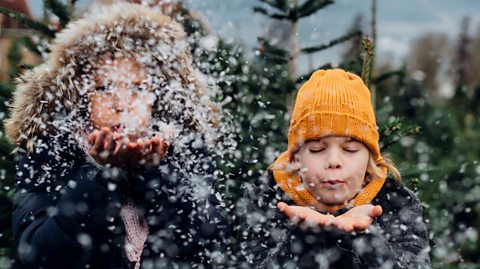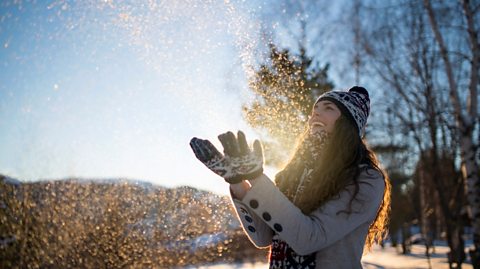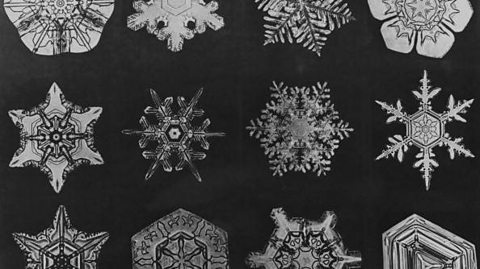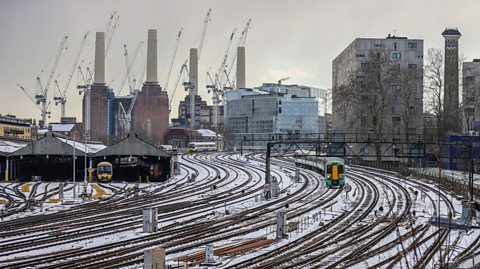Human beings - we’re made up of a lot of the same biological stuff but we don’t all look alike, do we?
The same goes for two daisies growing side-by-side or apples growing from the same tree. They may look alike, but examine them more closely and they’re different, each with that little spark of individuality.

Snowflakes are renowned for their uniqueness. No matter how many billions of them fall from the sky, there are never two the same.
Our naked eye sees snow as unremarkable white dots. However, in 1885, scientist Wilson Bentley devised a clever way of attaching his camera to a microscope so he could take photographs of snowflakes in greater detail than ever before. Getting this close made it even clearer that no two flakes were the same, no matter how many Mr Bentley examined. So let’s break this down.

What is a snowflake anyway?
Conditions in the clouds need to be just right for flakes to form. Temperatures must be lower than about -10 degrees Celsius at the same time as the air is saturated with gaseous evaporated water (called water vapour).
This causes ice crystals to form around tiny objects such as particles of clay or salt. Initially they are too light to fall and only begin their descent when they grow big enough.
That descent happens when super-cooled water droplets evaporate and then the water vapour condenses onto the surface of the ice crystal. That makes them bigger - as well as heavier - and now they can fall to earth as a flake.

Why do we associate snowflakes with star shapes?
They may be tiny but there is complicated science happening within each and every flake. That’s all down to what happens when water freezes. Every single time this happens, the flake’s molecules arrange themselves into a distinctive six-sided honeycomb-type structure.
This six-sided shape is because of the way the hydrogen and oxygen atoms inside the molecules behave when they encounter other water molecules. They link up in a strict pattern known as six-fold symmetry (that’s why we tend to associate snowflakes with hexagons or six-pointed stars) which gives us the basic snowflake template. That shape changes even further as they fall through the air.
 Image source, GETTY
Image source, GETTYIs each one actually unique?
As each snowflake falls, it encounters water vapour in the atmosphere. This has a big effect on its shape.
If humidity is low, there isn’t as much water vapour in the atmosphere so the snowflakes form something called 'plates', the flat hexagonal shapes you see if you look at them under a microscope.
If humidity is high, with more water vapour in the atmosphere, something called branching happens. Here the molecules form straight lines (dendrites) which branch out in different directions, creating the star-like patterns we tend to see on Christmas decorations. High humidity also creates bigger flakes, as there’s more vapour for the flakes to fall through.
Because a snowflake’s shape evolves as it journeys through the air, no two will ever be the same. Even two flakes floating side by side will each be blown through different levels of humidity and vapour to create a shape that is truly unique.
Do different snowflakes make for different kinds of snow (and which is best for a snowball fight)?
Once snowflakes hit the ground (provided they don’t melt straight away), they form a layer of snow. And, you’ve guessed it , not all layers are the same. The shape of the flakes affects the depth of the snow as dendrites don't pack together as well as plates.
Powder is the type of snow favoured for skiing and sledging. It is soft, moves around easily and doesn’t hurt too much if you fall into it. It forms when flakes formed of dendrites fall on frozen ground.
Granular snow is best for making for making snowmen and snowballs. It happens when the flakes that fall are covered with frozen water droplets. Wetter and more dense than powder, this is also the kind that can disrupt road and rail if there’s too much of it.
Crust is where the top layer of snow is completely frozen. The air warms up this layer, melting it, then refreezes it as the temperature drops.
Slush is something we've all walked through with cold toes. It happens when the ground is warm and melts the snow as it lands or the snow that falls is slightly above freezing, so it's already melting before it hits the ground.
And if you’ve ever wondered why snow is white, that’s the light you’re seeing reflected by the plates and dendrites.
Snowflakes are actually transparent.
This article was published in January 2019
What are the different seasons?
Why we have four very different periods in a year.

Snow patrol apps and other cool ideas to avoid snow chaos
The UK always seems to grind to a halt when it snows, but these other countries have clever ways of keeping running.
